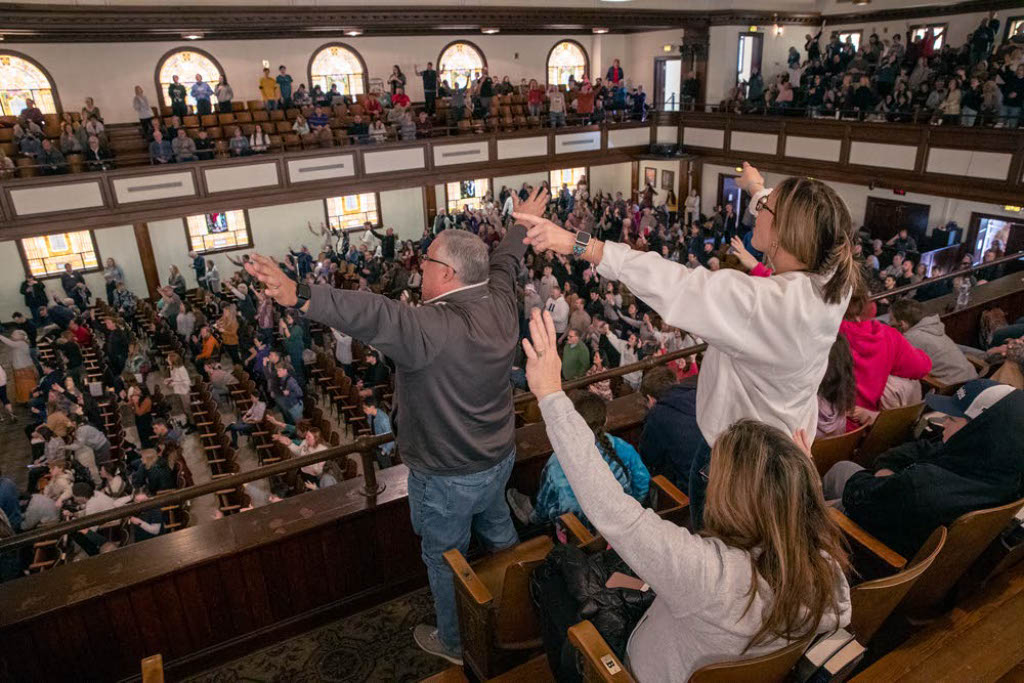Let’s hope it’s real. Shall we say that at the outset? The sight of hundreds of students singing, praying, and confessing at the altar in their college chapel for two weeks is uplifting for us all—if the revival is real.
Tiny Asbury University has a history of spiritual outpourings. But this may be the first one fueled or extended by social media. Tik-Tok and YouTube are replete with videos, short and long, of the non-stop worship experience that emerged from an ordinary chapel service on Feb. 8.
Within a couple of days, people were coming from everywhere to join the unending worship service. Lines were soon a half-mile long to get into the chapel. Speculation quickly arose whether the revival would break out on other campuses, as it did after the famous 1970 Asbury Revival.
Lee College in Cleveland, Tennessee, and Cedarville (Ohio) University ultimately reported extended worship sessions in February, as did Samford University, a Baptist school in Birmingham.
And a small group of students from Hannibal-LaGrange University traveled to the Asbury Campus to witness the event.
“My hope and prayer is that this is a genuine movement of God that will call a generation to faith in Christ,” HLGU President Robert Matz told the Illinois Baptist. “Those who study revivals know that they come after seasons of genuine prayer, fasting, repentance, and confession of sin.
“Last year, HLGU experienced a crisis and through prayer, fasting, repentance, and confession saw God’s kind provision,” Matz said. “Assuming this is a genuine work of the Holy Spirit, our hope at HLGU is that Lord would not pass over us. Instead, we long for a genuine work of the Spirit of God that leads to praise, confession, repentance, recommitments, and salvations.”
History repeating
This isn’t the first time such a prolonged gathering has happened in Wilmore, Kentucky. What is original to this outbreak is the posting of thousands of videos and Instagram responses, producing a steady stream of visitors to the campus chapel. And there’s abundant coverage from the Christian Broadcasting Network and others speculating that this revival will change the world, while equally strong opponents declare it vapid emotionalism.
The woman who drove from south Georgia to Wilmore so her children can participate in Holy Spirit history wanted it to be real. So did the man from Mississippi who jumped in his truck to drive north just an hour after hearing about the unending confessions two states away. And the couple who flew from Europe. And so on.
But not everyone is convinced. One apologist asked whether the social media that drew the crowd also put undue pressure on students to continue the event, and people on other campuses to copy it. Why would we need to drive to a “Holy Spirit hot spot”? Can’t the Spirit of God be poured out anywhere at any time without some kind of low-church, hand-me-down apostolic succession?
The 1970 revival spread when Asbury students traveled to churches and colleges sharing their testimonies. The most effective were the least skilled speakers, according to a 2010 documentary posted on YouTube. That revival ultimately spread to 130 campuses. It came in the environment of VietNam protests, the Kent State shootings, and the rise of the Jesus People Movement.
(Ironically a movie called Jesus Revolution featuring one of the founders, Greg Laurie, was released Feb. 22, just as Asbury administrators were trying to reroute spectators to local churches and return campus life to near normal.)
The first of six Asbury Revivals followed the 1904 Welsh Revival and was simultaneous to the 1906 Azusa Street Revival. The 1950 Asbury Revival came a couple of months after Billy Graham’s inaugural Los Angeles tent revival swelled from three to 16-weeks.
Apparently, revival does not happen in isolation.
The proof is not in the numbers of people, or places it occurs, or how it is generated, but in the results, as many observers have pointed out. How many were saved? How many had their lives turned Godward? How many were called to missions?
Not every purported revival produces such world-changing results. Frankly the Toronto Blessing Laughing Revival of 1994 comes to mind, as does the highly criticized six-year Brownsville Revival beginning in 1995, that conveniently relocated from Texas to the Florida panhandle when its evangelist moved on.
Still, we all want revival to be real, even if it breaks out first among people with holiness roots, instead of Baptists. SBC pastor and prayer leader Bill Elliff called the 2023 Asbury Revival “a wonderful mercy drop.”
“Millions of desperate believers in our nation are crying out for the next nationwide spiritual awakening,” Elliff posted after spending five days on the campus. “Small outbreaks are happening everywhere.”
As Elliff indicated, we should continue to pray that it’s so.

